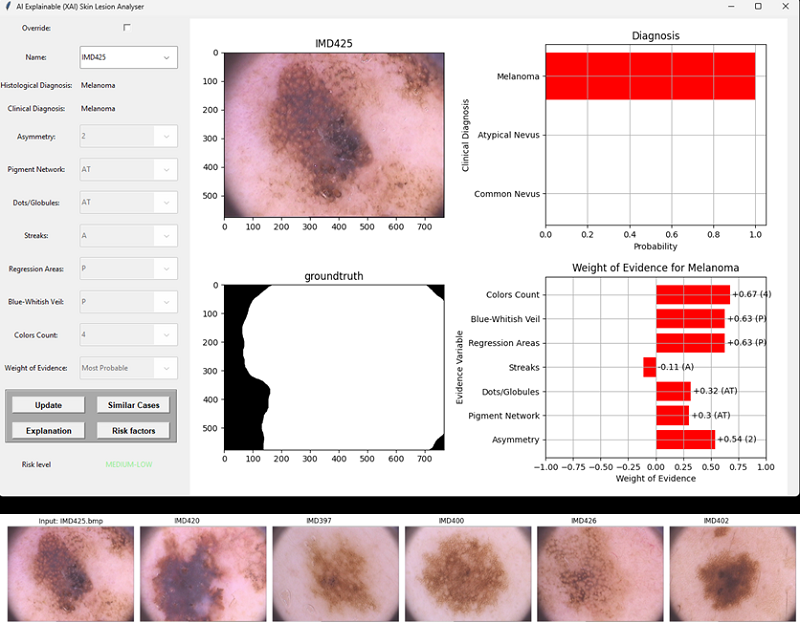Explainable AI for Skin Lesion Detection in a Clinical Environment
Melanoma is the 5th most common cancer in the UK and early detection is essential for successful treatment. Around 16,700 people are diagnosed with melanoma in the UK each year [1]. The number of people diagnosed with melanoma has increased over the last few decades. According to Getting It Right First Time (GIRFT) national report for dermatology [2] one in four people in England and Wales (13.2m) see their general practitioner (GP) about a dermatological condition every year. Dermatologists have been overwhelmed by the number of referrals they have received from GPs who were looking for a specialist to decide if skin lesions needed some further investigation. However, only around 6% of referrals lead to a diagnosis of skin cancers and need to be seen by a specialist dermatologist [3].
Diagnostic procedures
Computer Aided diagnostic procedures for the automatic detection of melanoma could benefit patient survival rates.
Unfortunately, while many current machine learning techniques claim outstanding accuracy,
these techniques provide poor or no explanations of their diagnostic predictions and are highly susceptible
to biases in training data [4] making it difficult for a GP to utilise in a clinical environment.
Doctors frequently use diagnostic procedures to diagnose melanoma.
The standard method used by GPs is called the ABCD rule, which includes measuring the Asymmetry (A),
Border (B), Colour (C) and Diameter(D) of the lesion.
This rule, however, is ambiguous and unreliable when diagnosing rarer types of melanomas
or distinguishing some types of seborrheic keratosis [5].

Figure 1. ABCD stands for Asymmetry (A), Border (B), Color (C), Diameter (D). These are the characteristics of skin damage that doctors look for when diagnosing and classifying melanomas.
Explainable AI Skin Lesion Analyser (XAI-SLA)
Following HRA/HCRW approval (IRAS 284034) in June 2022 [6], our research team has analysed anonymised data
collected from thousands of NHS patients. The dataset has been maintained by the Dermatology Department
at the University Hospital of Wales, Cardiff.
The research team has implemented feature extraction algorithms for automating ABCD rules to produce melanoma detection algorithms
suitable for GPs. Implemented feature detection algorithms are bi-fold asymmetry measurements and fractal box-counting border detection.
Skin lesion segmentation uses LBPC instead of SegNet to detect border irregularity using fractal box-counting.
Furthermore, bi-fold colour asymmetry was improved using superpixels to create a flexible border to avoid features.
In addition, various dermoscopic structures such as dots/globules, regression areas, blue-whitish vail etc have been used to train machine learning model.
A probabilistic model has been developed to compute the probability distribution of the presence or absence of skin cancer,
given the above mentioned clinically important features, combined with risk factors such as red hair, freckling, sunburn, age,
the presence of many melanocytic nevi and the family history of melanoma.

Figure 2. Interface of the Explainable AI Skin Lesion Analyser (XAI-SLA)
The Explainable AI Skin Lesion Analyser (XAI-SLA) shown in Figure 2,
not only presents the probabilistic diagnosis of the skin lesion but also evaluates the strength of evidence,
facilitates the retrieval of similar, previously diagnosed cases, and provides a
textual explanation of the diagnosis including detected clinical features and risk factors [7].
This innovative AI tool is not meant to be a replacement for human expertise but fully interpretable algorithm
to support diagnostic assessment. Following clinical evaluation, if widely adopted,
this tool could contribute towards reducing unnecessary referrals,
create significant capacity in the service and reduce NHS backlogs [8].
The project has been conducted in collaboration with Cardiff and Vale University Health Board,
REU headed by Professor Colin Gibson, with Dr Adam Partlow a Senior Clinical Scientist,
acting as the custodian for the data generated by the study, Mr Elliot Naylor a PhD student involved in the AI development
and Dr Richard Motley a Consultant Dermatologist, UHW.
Funding
This work was supported by the Welsh Government’s ESF-Funded Knowledge Economy Skill Scholarship with the Cardiff and Vale University Health Board’s Rehabilitation Engineering Unit and University of South Wales, under Grant KESS II 21430.
References
-
Cancer Research UK,
-
GIRFT Dermatology, Programme National Special Report, August 2021
-
NHSE and British Association of Dermatologists, The two-week wait skin cancer pathway, April 2022.
-
Akhila Narla, Brett Kuprel, Kavita Sarin, Roberto Novoa, Justin Ko, Automated Classification of Skin Lesions:
From Pixels to Practice, Journal of Investigative Dermatology, Volume 138, Issue 10, 2018, Pages 2108-2110, ISSN 0022-202X,
https://doi.org/10.1016/j.jid.2018.06.175
-
Carrera C, Segura S, Aguilera P, et al. Dermoscopic Clues for Diagnosing Melanomas That Resemble Seborrheic Keratosis.
JAMA Dermatol. 2017;153(6):544–551.
https://pubmed.ncbi.nlm.nih.gov/28355453/
-
J. Kulon, E. Naylor, S. Downes, A. Partlow, and C. Gibson,
Clinical Study: Clinical Decision Support System for Skin Monitoring and Skin lesion Classification using Machine Learning (IRAS ID 284034)
https://www.hra.nhs.uk/planning-and-improving-research/application-summaries/research-summaries/skin-lesion-detection-in-a-clinical-environment/
-
J. Kulon, E. Naylor, A. Partlow, and C. Gibson, ‘An interpretable AI tool supporting diagnosis of skin conditions’.
Journal of Investigative Dermatology, 2023 (manuscript in preparation)
https://www.jidonline.org/
-
Inspiring Innovation – June Edition
https://lshubwales.com/news/inspiring-innovation-june-edition?mc_cid=ed33200d18&mc_eid=2a542368a4
-
USW researchers working on app that could help GPs spot potential skin problems
https://www.southwales.ac.uk/news/news-for-2023/usw-researchers-working-on-app-that-could-help-gps-spot-potential-skin-problems/
